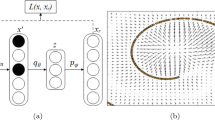Abstract
Deep neural networks are a state-of-the-art method used to computer vision. Imperceptible perturbations added to benign images can induce the deep learning network to make incorrect predictions, though the perturbation is imperceptible to human eyes. Those adversarial examples threaten the safety of deep learning model in many real-world applications. In this work, we proposed a method called denoising sparse convolutional autoencoder (DSCAE) to defense against the adversarial perturbations. This is a preprocessing module works before the classification model, which can remove substantial amounts of the adversarial noise. The DSCAE defense has been evaluated against FGSM, DeepFool, \( \hbox {C} \& \hbox {W}\), JSMA attacks on the MNIST and CIFAR-10 datasets. The experimental results show that DSCAE defends against state-of-art attacks effectively.
















Similar content being viewed by others
References
Akhtar N, Mian A (2018) Threat of Adversarial Attacks on Deep Learning in Computer Vision: A Survey. arXiv e-prints arXiv:1801.00553
Alex K, Ilya S, Hg E (2012) Imagenet classification with deep convolutional neural networks. In: Proceedings of NIPS, IEEE, Neural Information Processing System Foundation, pp 1097–1105
A Krizhevsky VN, Hinton G (2009) Cifar-10 and cifar-100 datasets. https://www.cs.toronto.edu/~kriz/cifar.html. Accessed 11 July 2020
Bakhti Y, Fezza SA, Hamidouche W, Deforges O (2019) Ddsa: a defense against adversarial attacks using deep denoising sparse autoencoder. IEEE Access 7:160397–160407. https://doi.org/10.1109/ACCESS.2019.2951526
Biggio B, Roli F (2018) Wild patterns: ten years after the rise of adversarial machine learning. Pattern Recognit 84:317–331
Cao N, Li GF, Zhu PJ, Sun Q, Wang YY, Li J, Yan ML, Zhao YB (2019) Handling the adversarial attacks: a machine learning’s perspective. J Ambient Intell Hum Comput 10(8):2929–2943
Carlini N, Wagner D (2016) Towards Evaluating the Robustness of Neural Networks. arXiv e-prints arXiv:1608.04644
Gong Z (2018) Craft image adversarial samples with tensorflow. https://github.com/gongzhitaao/tensorflow-adversarial/tree/v0.2.0.Accessed 11 July 2020
Goodfellow I, McDaniel P, Papernot N (2018) Making machine learning robust against adversarial inputs. Commun ACM 61:56–66. https://doi.org/10.1145/3134599
Goodfellow IJ, Shlens J, Szegedy C (2014) Explaining and Harnessing Adversarial Examples. arXiv e-prints arXiv:1412.6572
Gu S, Rigazio L (2014) Towards Deep Neural Network Architectures Robust to Adversarial Examples. arXiv e-prints arXiv:1412.5068
Gu T, Dolan-Gavitt B, Garg S (2017) Badnets: Identifying vulnerabilities in the machine learning model supply chain
Hinton G, Deng L, Yu D, Dahl GE, Mohamed AR, Jaitly N, Senior A, Vanhoucke V, Nguyen P, Sainath TNJISPM (2012) Deep neural networks for acoustic modeling in speech recognition: the shared views of four research groups. IEEE Signal Process Mag 29(6):82–97
LeCun Y (1998) The mnist database of handwritten digits. http://yann.lecun.com/exdb/mnist/.Accessed 11 July 2020
Lee H, Han S, Lee J (2017) Generative Adversarial Trainer: Defense to Adversarial Perturbations with GAN. arXiv e-prints arXiv:1705.03387
Li Y, Huang JB, Ahuja N, Yang MH (2016) Deep joint image filtering. vol 9908, https://doi.org/10.1007/978-3-319-46493-0_10
Liu W, Wang Z, Liu X, Zeng N, Liu Y, Alsaadi F (2016b) A survey of deep neural network architectures and their applications. Neurocomputing 234:11–26. https://doi.org/10.1016/j.neucom.2016.12.038
Liu S, Pan J (2016a) Yang MH. Learning recursive filters for low-level vision via a hybrid neural network. 9908:560–576. https://doi.org/10.1007/978-3-319-46493-0_34
Melis M, Demontis A, Biggio B, Brown G, Fumera G, Roli F (2017) Is Deep Learning Safe for Robot Vision? Adversarial Examples against the iCub Humanoid. arXiv e-prints arXiv:1708.06939
Moosavi-Dezfooli SM, Fawzi A, Frossard P (2015) DeepFool: a simple and accurate method to fool deep neural networks. arXiv e-prints arXiv:1511.04599
Nitin Bhagoji A, Cullina D, Sitawarin C, Mittal P (2017) Enhancing Robustness of Machine Learning Systems via Data Transformations. arXiv e-prints arXiv:1704.02654
Papernot N, Mcdaniel P, Jha S, Fredrikson M, Celik ZB, Swami A (2015) The limitations of deep learning in adversarial settings. In: IEEE European Symposium on Security & Privacy
Shen X, Chen YC, Tao X, Jia J (2017) Convolutional Neural Pyramid for Image Processing. arXiv e-prints arXiv:1704.02071
Szegedy C SIBJEDGI Zaremba W (2013) Intriguing properties of neural networks. arXiv e-prints arXiv:1312.6199
Xu H, Ma Y, Liu HC, Deb D, Liu H, Tang JL, Jain AK (2020) Adversarial attacks and defenses in images, graphs and text: a review. IEEE Signal Process Mag 17(2):151–178
Xu W, Evans D, Qi Y (2017) Feature Squeezing: Detecting Adversarial Examples in Deep Neural Networks. arXiv e-prints arXiv:1704.01155
Acknowledgements
This work is supported by the National Natural Science Foundation of China under Grant No. 61966011 and the Project of Educational Commission of Guangdong Province of China(2018GKTSCX114, 2018GKTSCX068).
Author information
Authors and Affiliations
Corresponding author
Additional information
Publisher's Note
Springer Nature remains neutral with regard to jurisdictional claims in published maps and institutional affiliations.
Rights and permissions
About this article
Cite this article
Ye, H., Liu, X. & Li, C. DSCAE: a denoising sparse convolutional autoencoder defense against adversarial examples. J Ambient Intell Human Comput 13, 1419–1429 (2022). https://doi.org/10.1007/s12652-020-02642-3
Received:
Accepted:
Published:
Issue Date:
DOI: https://doi.org/10.1007/s12652-020-02642-3




